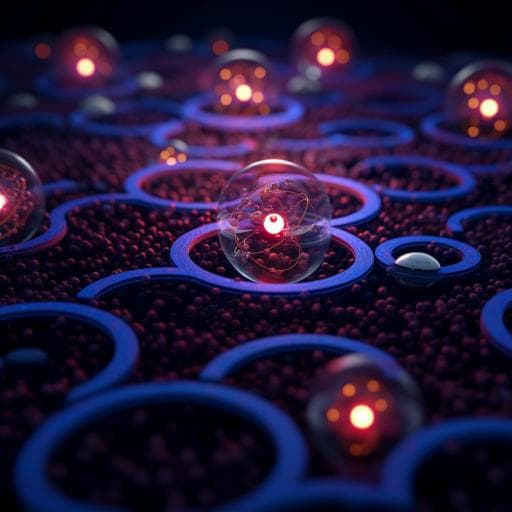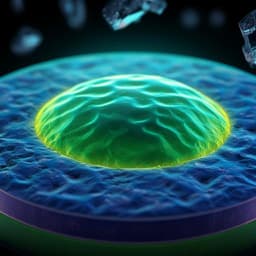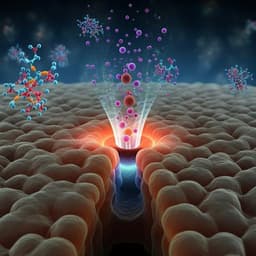
Chemistry
Single-atom-layer traps in a solid electrolyte for lithium batteries
F. Zhu, M. S. Islam, et al.
This research conducted by Feng Zhu, Md Shafiqul Islam, Lin Zhou, Zhenqi Gu, Ting Liu, Xinchao Wang, Jun Luo, Ce-Wen Nan, Yifei Mo, and Cheng Ma unveils the critical role of single-atom-layer traps (SALTs) in hindering lithium-ion transport in solid electrolytes. Discover how these microscopic defects impact ionic conductivity in Li0.33La0.56TiO3 and reveal a new perspective on material performance.
~3 min • Beginner • English
Introduction
Solid electrolytes promise enhanced safety and higher energy density compared to flammable liquid electrolytes but achieving liquid-like ionic conductivity remains challenging. Understanding Li-ion transport requires considering both periodic lattices and non-periodic features (defects, interfaces). Non-periodic features are intrinsic due to thermodynamics and can substantially affect transport, as shown for grain boundaries and various point defects in multiple systems. However, detailed atomistic mechanisms of many non-periodic features (e.g., grain boundaries, dislocations, stacking faults, twin boundaries) remain underexplored, in part due to their localized nature and low volume fraction. This study investigates additional non-periodic features in Li0.33La0.56TiO3 (LLTO), identifying single-atom-layer 2D defects forming closed loops (SALTs) and elucidating their impact on Li-ion migration via atomic-resolution microscopy and ab initio simulations.
Literature Review
Prior work shows grain boundaries can dominate resistance and lower conductivity by orders of magnitude in oxides and sulfides (e.g., Li2OX anti-perovskites, LLZO garnets, LLTO, NASICON). Interstitial Li+ can promote cooperative migration and enhance conductivity (Li4SiO4–Li3PO4, LLZO, Li1+xAlxTi2−x(PO4)3, LiTaSiO4). Proton substitutional defects (e.g., in Li3OCl, Al-doped LLZO) and Schottky defect pairs in Li-rich antiperovskites can affect Li-ion transport. Mixed polyanion effects and plastic-crystal behavior of polyanions can influence conductivity even when not directly involving charge carriers. Recent simulations have begun to clarify grain-boundary effects (e.g., Li3OCl, LLZO) and their differing roles in sulfides vs oxides, including cases where specific boundaries facilitate transport. Despite these insights, comprehensive studies of other potential non-periodic features (dislocations, stacking faults, twin boundaries) are scarce, motivating systematic identification and mechanistic analysis of additional defect types affecting Li-ion migration.
Methodology
Materials synthesis and characterization: LLTO ceramics (nominal Li0.33La0.56TiO3) were prepared by a sol–gel method. Precursors (LiNO3, La(NO3)3·6H2O in ethylene glycol monomethyl ether, tetrabutyl titanate, acetylacetone) were gelled, dried at 70 °C, calcined at 900 °C for 6 h, ball-milled 12 h, pressed, sintered at 1350 °C for 6 h, and annealed at 800 °C for 3 days. Pellets were buried in same-composition powder to compensate Li loss. Density by Archimedes; phase checked by XRD; stoichiometry by ICP (Li:La:Ti = 0.325:0.552:1); ionic conductivity by EIS (AC) and DC (3.55 × 10−5 S cm−1), consistent with literature. TEM sample prep: mechanical thinning and Ar-ion milling at −100 °C (3 kV/4 mA, then 1.5 kV/3 mA) and stored in 10−5 torr. Electron microscopy: Aberration-corrected FEI Titan Themis TEM/STEM at 200 kV, dose <12 e− Å−2 s−1. HAADF-STEM and ABF-STEM imaging (Fourier-filtered). EDX mapping for heavy elements; EELS (Gatan GIF Quantum-965) with 5 mm aperture, 0.1 eV/channel for Li-K, Ti-L2,3, O-K; line scans across defects; Li-K assignment validated by comparing La-rich vs La-poor LLTO layers. Image simulations: QSTEM; strain mapping by GPA; isolated volume fractions quantified via ImageJ. Computational methods: DFT (VASP, PAW, PBE-GGA) with Materials Project convergence settings. Supercell model: two LLTO slabs and two defect layers under periodic boundary conditions (CIF provided). Configurational sampling: 10,000 symmetry-distinct configurations screened by electrostatics; 100 selected for DFT; lowest-energy configurations chosen for LLTO and defect layers following a prior scheme. NEB: 378-atom supercell (11.83 Å × 11.75 Å × 31.84 Å), nine images, converged to 0.01 eV Å−1; migration paths chosen from AIMD-observed trajectories. AIMD: 202-atom supercell (11.83 Å × 11.75 Å × 16.62 Å) at 2000 K, NVT Nosé–Hoover, 2 fs timestep, 80 ps, Γ-point, non-spin-polarized; La-poor layer removed to reduce cost. Li diffusivity in defect evaluated from in-plane Li displacements. Comparative NEB on β-Li2TiO3 (C2/c) along analogous paths.
Key Findings
- Identification of SALTs: Atomic-resolution HAADF-STEM revealed abundant single-atom-layer 2D defects in LLTO lying exclusively in {001}p planes, often forming mutually orthogonal closed loops (SALTs) that enclose 3D volumes; such loops are ubiquitous, sometimes sharing edges; observed also in unthinned crushed particles.
- Local chemistry: EDX shows La depletion (dark La map loops matching SALTs). EELS line scans show Li-K intensity peaks at defects indicating Li enrichment; Ti-L2,3 fine structure and O-K edges indicate Ti4+ and TiO6 octahedra present in defects with slight distortions relative to LLTO; no significant Ti or O content change.
- Structural model: Adjacent LLTO cells are shifted by 1/2[110]p across the defect. The defect layer is single-atom-thick, isostructural with the {001} plane of rock-salt γ-Li2TiO3 (Fm3̄m), epitaxially interfaced with LLTO. ABF-STEM visualizes O-only columns consistent with the model; image simulations agree. Charge balance considerations indicate cation vacancies and a composition approximated as [Li0.37Ti0.33O]0.31 (equivalently [LiTiO3]0.93−), with Li concentration in the defect ~2.06–2.23× that in bulk LLTO.
- Transport across/within defects: Adjacent LLTO A-site planes near defects are La-rich, known Li-ion-blocking, preventing perpendicular transport across the defect. AIMD at 2000 K shows Li migration confined within the defect layer; no crossing observed. In-plane Li mobility is strongly reduced vs bulk LLTO, with shorter Li–O distances in the defect (from g(r)), implying compressed migration volumes and higher barriers.
- Migration barriers: NEB on three in-plane paths within the defect shows barriers ~0.8–1.2 eV (≈1.2 eV across Ti chains; ≈0.8 eV beside chains), higher than β-Li2TiO3 (0.49–0.53 eV), implying even slower Li diffusion than β-Li2TiO3 (estimated σRT ≈ 2.43 × 10−12 S cm−1). Barriers insensitive to adjacent LLTO A-site configuration but dependent on Ti/Li/vacancy arrangement within the defect.
- Macroscopic impact: SALTs isolate substantial volumes (individual loop sizes ~15 nm to 1 μm in grains of 2–4 μm; many grains host multiple SALTs). Estimated average isolated volume fraction is 15.7 vol% across grains examined. This effectively adds 15.1 vol% non-conductive porosity to a 96.3% dense pellet (3.7% pores), a level expected to reduce conductivity by 1–2 orders of magnitude in oxide electrolytes. Measured pellet DC conductivity: 3.55 × 10−5 S cm−1; bulk LLTO exhibits high bulk conductivity ~10−3 S cm−1 in literature.
Discussion
The study addresses how previously overlooked non-periodic features impact Li-ion transport in solid electrolytes. SALTs, formed by single-atom-layer Li–Ti–O defects isostructural with γ-Li2TiO3 {001}, act as strong Li-ion blockers. Their presence transforms adjacent LLTO A-site planes into La-rich, Li-blocking layers, prohibiting ion migration across the defect; in-plane diffusion within the defect is intrinsically sluggish due to compressed Li–O environments and high migration barriers. As these 2D layers form closed loops, they isolate internal volumes from participating in macroscopic transport, effectively reducing the active conductive fraction of the ceramic, consistent with the observed disparity between high intrinsic bulk conductivity and lower pellet conductivities. Given their ubiquity and sizable isolated volumes, SALTs likely contribute significantly to overall conductivity degradation, underscoring the necessity to include such features in mechanistic models and materials optimization strategies for solid electrolytes.
Conclusion
SALTs—closed loops of single-atom-layer Li–Ti–O defects—isostructural with γ-Li2TiO3 {001}—are ubiquitously present in LLTO and severely impede Li-ion transport by blocking cross-plane migration and drastically slowing in-plane diffusion. Atomic-resolution microscopy and spectroscopy established their structure and composition; ab initio simulations revealed high migration barriers and confinement of Li motion within the defect layer. The resulting isolation of substantial material volumes (≈15.7 vol% on average) is expected to reduce macroscopic conductivity by 1–2 orders of magnitude, helping explain performance gaps between intrinsic bulk and pellet conductivities. This work highlights the critical role of non-periodic features beyond traditional point defects and grain boundaries and motivates targeted synthesis/processing strategies (e.g., minimizing Li/O loss) to suppress SALT formation and similar defects in a broad range of solid electrolytes. Future research should quantify SALT populations across chemistries, directly measure their electrical impact, develop mitigation routes, and compare their effects with those of grain boundaries and other extended defects.
Limitations
- Direct quantitative separation of SALT vs grain boundary contributions to total resistance was not achieved; reliable grain boundary simulations remain challenging.
- The exact defect stoichiometry is inferred from charge balance and spectroscopy with some uncertainty; Li quantification by EELS is semi-quantitative.
- AIMD simulations were conducted at elevated temperature (2000 K) and on reduced models for computational tractability; extrapolation to room temperature is indirect.
- The conductivity within the SALT layer is not directly measured; comparisons to β-Li2TiO3 and barrier calculations indicate trends rather than absolute transport values.
- Potential formation mechanisms are inferred (favored by Li/O loss at high sintering temperatures); experimental elimination strategies were not tested.
Related Publications
Explore these studies to deepen your understanding of the subject.







